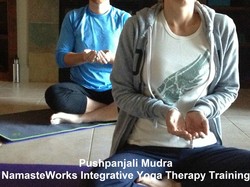 During the past weeks of class, we have been practicing the Pushpanjali Mudra during our opening time of breathing and centering. Pushpanjali means an offering of flowers. I picked this mudra because it is known for reducing stress and the lowering of blood pressure and aides in "releasing attachments at all levels of being" * while cultivating generosity. Pushpanjali is for "cultivating non-grasping - Aparigraha."* The Yamas are the first of 8 Limbs of Yoga. See my blog from September 2013 for more on the Limbs of Yoga: http://www.yogawithgrace.net/pams-blog/8-limbs-of-yoga . The Yamas are a list of ways we interact with others. Aparigraha (a-par-I-gra-ha) is the fifth Yama and is translated to mean non-grasping, non-coveting or non-possessing. The idea is to look at our lives and see where we hold onto stuff or yearn for stuff others have. "Stuff" is either physical things or more spiritual, internal stuff. As we look around at the things we posses we ask the question, do I really need it? What does it really do for me? Then we look inside to find what we might be holding onto, memories, hurts, titles, and more. These things we hold onto block us from really moving onto compassion and generosity. Practicing Aparigraha actually brings us to the point of interacting better with others. For example, if we covet something a friend has or does it blocks us from truly getting close to her. Practicing aparigraha, we would celebrate that she has a great job, blonde hair, or can crochet. When we aparigraha with our physical stuff, we find ourselves more able to let go off it and share it with others who do not have. When we practice aparigraha we celebrate that we can do the Tree Pose even when it looks a little different then the person next to us. The article "7 Ways to Practice Aparigraha" by Irene Petryszak is a great and easy read on how to practice Aparigraha. Irene lists and explains the following steps: Let It Go, Breathe, Practice Self-Care, Be Positive, Forgive, Practice, and Be Generous. The post "Aparigraha" on www.earthdancehealingarts.com is also focused on the practical aspects of Aparigraha. Jen explores how we can apply Aparigraha to many aspects of our lives including our yoga practice and our personal view of ourselves. Jen also lists some important questions to ask ourselves as we continue to practice Aparigraha. Give the article and the blog a read and let me know if you found them helpful. If you click on the green highlighted titles, the article and the blog with come up on a separate screen. Feel free to respond to this blog about your practice of Aparigraha. *from Mudras For Healing and Transformation by Josepha and Lilian Le Page Article on Pushpanjali: http://namasteworksyoga.com/pushpanjali-mudra-appreciate-life-just-as-it-is
0 Comments
This morning I was watching a national news program that showed a film clip of a woman doing a yoga pose on a plank suspended off the side of a tall building. It was a nice pose, but it looked scary. The tallest platform I have used is a snow pile!
This film clip has brought about a debate on the safety and ethics of doing yoga that is potentially risky and then sharing it with others. To me it is Rachelle's practice and choice. We do not have to follow her choice. My issue is what was the motivation behind Rachelle's practice of her pose on the plank. Was her motivation out of some sort of greed or grasping? Was she coveting some sort of title or eliteness? In yoga we practice aparigraha which is one of the Yamas expressed in Patanjali's Sutras. Aparigraha is the expression of non-grasping or non-possessing or non-coveting. Rachelle's need to practice her pose on a plank might have been some sort of challenge for her practice, but since she recorded it to be seen by the world, I think there was some sort of greed behind her motives. Link to the Film Clip: http://www.today.com/health/stunning-or-dangerous-stunt-yoga-pose-ledge-sparks-debate-2D80172134 There has been a study posted that practicing yoga "boost brain function in older adults." Awesome news! Of course we knew this from experience. The study followed people ages 55 - 79. Some practiced yoga 3 times per week. The others did a program of stretching and toning. Those that participated in yoga had "significant improvements in work memory capacity." These folks where also able to do tasks without being distracted. Those folks that participated in the program of stretching and toning did not have these changes!
So keep up the great work! Please let me know how your yoga practice has helped you with your memory and general every day activities. Click below for article: Hatha Yoga May Improve Brain Function in Older Adults
|
AuthorI enjoy yoga as it brings peace to my life. Teaching yoga has brought joy to my life and given me a chance to encourage others in learning yoga. Archives
July 2020
Categories
All
|
 RSS Feed
RSS Feed
